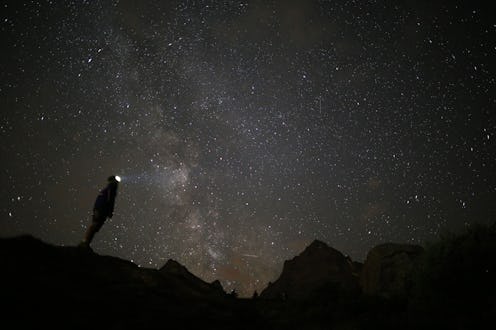Life
The History Of The Orionid Meteor Shower
Stargazers, rejoice! For the next few weeks, you may be able to catch glimpses of the Orionid meteor shower. The history of the Orionids is rooted in a constellation rich in mythology and the most famous comet known to man. So, you know, not too shabby.
The Orion meteor shower is visible now, but the meteors will peak just before dawn on Thursday, Oct. 20, and Friday, Oct. 21. If you don’t see any meteors then, you’ll have a bunch of other opportunities, as the Orionids will be flying through the sky through Nov. 7. If you get the timing right this year, you may be able to see 15 to 20 meteors an hour.
Meteors, which humans see as bright lines flashing across the night sky, are often referred to as “shooting stars,” though, of course, they are not stars at all. The origins of the Orionids are still pretty cool, however. A meteor is an object (often some form of debris) traveling through space that enters and burns up in Earth’s atmosphere, creating a streak of light. The Orionids are made up from debris from Halley’s Comet (1P/Halley), the most famous comet in human history. Halley’s Comet is only visible to humans every 75 years or so, with it’s last appearance occurring in 1986.
The comet's first recorded sighting occurred way back in 239 B.C. In 1705, English astronomer Edmond Halley theorized that certain comets that had been sighted periodically throughout history were in fact the same comet returning to Earth in a regular orbit. Though he didn’t live to see the comet’s next appearance, he was able to accurately predict its return, leading to comet to be named after him. (That’s an image of Halley’s comet, below, taken in 1910.)
Although Halley’s Comet isn’t set to appear again until 2061, we see evidence of the comet every year, in the form of the Orionids and another meteor shower, the Eta Aquariids. The comet leaves a trail of debris, and when the Earth intersects its orbit every year, that debris burns up in the atmosphere and creates the meteors.
Although the Orionid meteor shower originates with Halley’s Comet, its name comes from a different source: the constellation Orion. The Orionids radiate outward from a point near Orion’s sword, close to the large red star, Betelgeuse. (FYI, to view the Orionids, you don’t need to find Orion. They’ll move in all directions). The constellation is named for the mythological figure, Orion the Hunter. There are a number of stories about Orion, son of the sea god Poseidon, in ancient Greek mythology. Some stories figure him as a hunting companion to Artemis; in one version of the myth, Apollo tricks Artemis into shooting Orion, and in another, she kills him after he assaults one of her handmaidens. In another myth, Orion brags that he will hunt and kill all of the animals on Earth, leading Gaia to send a scorpion after him. Both Orion and the scorpion become constellations, though ones that never inhabit the same sky.
The best time to see the Orionids is early in the morning, before dawn. Grab a cozy blanket, a friend, and some coffee, and head out to a place far from the lights of the city. At worst, you’ll get to see the sunrise, and, at best, you’ll get to see the fiery remnants of Halley’s Comet streaking across the sky.
Images: The Yerkes Observatory; U.S. Naval Observatory Library/Wikimedia
